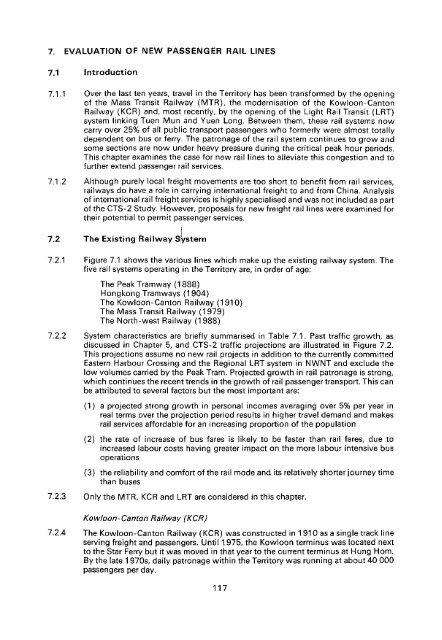Untitled - HKU Libraries - The University of Hong Kong
Untitled - HKU Libraries - The University of Hong Kong
Untitled - HKU Libraries - The University of Hong Kong
- No tags were found...
You also want an ePaper? Increase the reach of your titles
YUMPU automatically turns print PDFs into web optimized ePapers that Google loves.
7. OF7.1 introduction7.1.1 Over the last ten years, travel in the Territory has been transformed by the opening<strong>of</strong> the Mass Transit Railway, (MTR), the modernisation <strong>of</strong> the Kowloon-CantonRailway (KCR) and, most recently, by the opening <strong>of</strong> the Light Rail Transit (LRT)system linking Tuen Mun and Yuen Long. Between them, these rail systems nowcarry over 25% <strong>of</strong> all public transport passengers who formerly were almost totallydependent on bus or ferry. <strong>The</strong> patronage <strong>of</strong> the rail system continues to grow andsome sections are now under heavy pressure during the critical peak hour periods.This chapter examines the case for new rail lines to alleviate this congestion and t<strong>of</strong>urther extend passenger rail services.7.1.2 Although purely local freight movements are too short to benefit from rail services,railways do have a role in carrying international freight to and from China. Analysis<strong>of</strong> international rail freight services is highly specialised and was not included as part<strong>of</strong> the CTS-2 Study. However, proposals for new freight rail lines were examined fortheir potential to permit passenger services.7.2 <strong>The</strong> Existing Railway System7.2.1 Figure 7.1 shows the various lines which make up the existing railway system. <strong>The</strong>five rail systems operating in the Territory are, in order <strong>of</strong> age:<strong>The</strong> Peak Tramway (1 888)<strong>Hong</strong>kong Tramways (1904)<strong>The</strong> Kowioon-Canton Railway (1910)<strong>The</strong> Mass Transit Railway (1979)<strong>The</strong> North-west Railway (1988)7.2.2 System characteristics are briefly summarised in Table 7.1. Past traffic growth, asdiscussed in Chapter 5, and CTS-2 traffic projections are illustrated in Figure 7.2.This projections assume no new rail projects in addition to the currently committedEastern Harbour Crossing and the Regional LRT system in NWNT and exclude thelow volumes carried by the Peak Tram. Projected growth in rail patronage is strong,which continues the recent trends in the growth <strong>of</strong> rail passenger transport. This canbe attributed to several factors but the most important are:(1) a projected strong growth in personal incomes averaging over 5% per year inreal terms over the projection period results in higher travel demand and makesrail services affordable for an increasing proportion <strong>of</strong> the population(2) the rate <strong>of</strong> increase <strong>of</strong> bus fares is likely to be faster than rail fares, due toincreased labour costs having greater impact on the more labour intensive busoperations(3) the reliability and comfort <strong>of</strong> the rail mode and its relatively shorter journey timethan buses7.2.3 Only the MTR, KCR and LRT are considered in this chapter.Kowloon-Canton Railway (KCR)7.2.4 <strong>The</strong> Kowloon-Canton Railway (KCR) was constructed in 1910 as a single track lineserving freight and passengers. Until 1975, the Kowloon terminus was located nextto the Star Ferry but it was moved in that year to the current terminus at Hung Horn.By the late 1970s, daily patronage within the Territory was running at about 40 000passengers per day.117
















